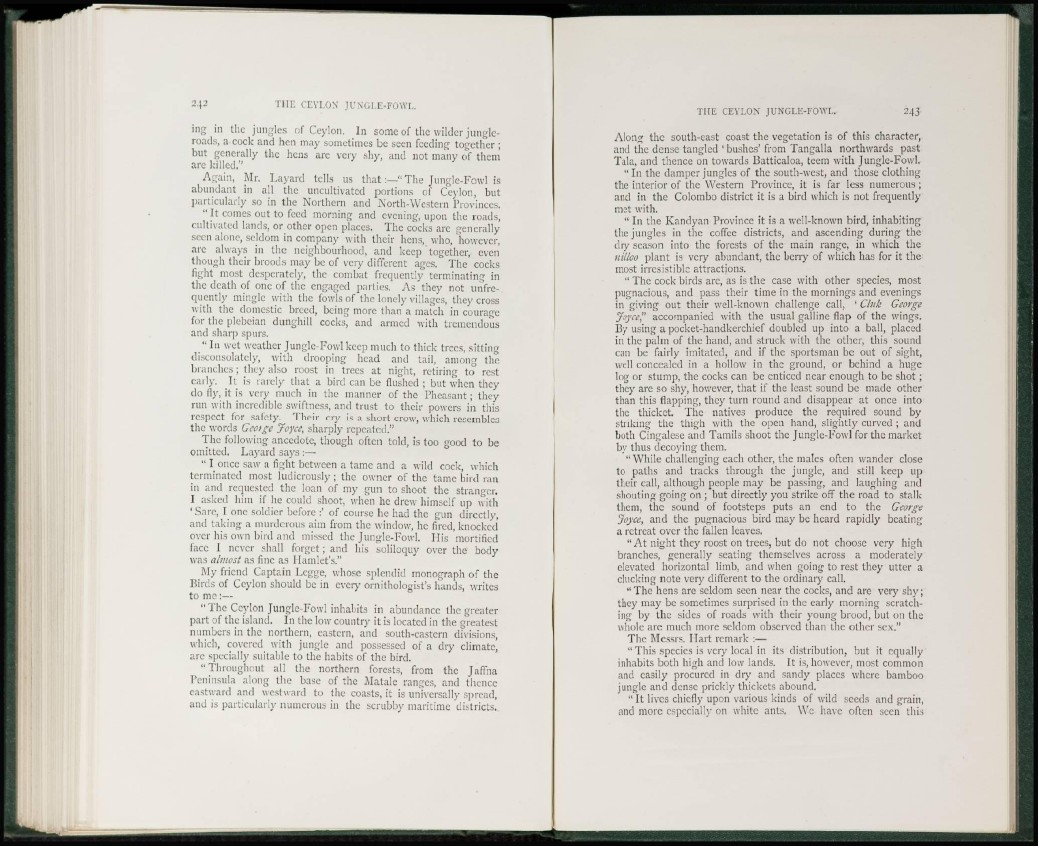
2.J2 IUI. CEYLON JUNGLE-FOWL.
ing in the jungles of Ceylon. In some of the wilder jungleroads,
a cock and hen may sometimes be seen feeding together ;
but generally the hens are very shy, and not many of them
are killed."
Again, Mr. Layard tells us that:—"The Jungle-Fowl is
abundant in all the uncultivated portions of Ceylon, but
particularly so in the Northern and North-Western Provinces.
" It comes out to feed morning and evening, upon the roads,
cultivated lands, or other open places. The cocks are generally
seen alone, seldom in company with their hens, who, however,
arc always in the neighbourhood, and keep together, even
though their broods may be of very different ages. The cocks
fight most desperately, the combat frequently terminating in
the death of one of the engaged parties. As they not unfrequcntly
mingle with the fowls of the lonely villages, they cross
with the domestic breed, being more than a match in courage
for the plebeian dunghill cocks, and armed with tremendous
and sharp spurs.
" In wet weather Jungle-Fowl keep much to thick trees, sitting
disconsolately, with drooping head and tail, among the
branches ; they also roost in trees at night, retiring to rest
early. It is rarely that a bird can be flushed ; but when they
do fly, it is very much in the manner of the Pheasant; they
run with incredible swiftness, and trust to their powers in this
respect for safety. Their cry is a short crow, which resembles
the words Gcoige Joyce, sharply repeated."
The following anecdote, though often told, is too good to be
omitted. Layard says :—
" I once saw a fight between a tame and a wild cock, which
terminated most ludicrously ; the owner of the tame bird ran
in and requested the loan of my gun to shoot the stranger.
I asked him if he could shoot, when he drew himself up with
'Sare, I one soldier before :' of course he had the gun directly,
and taking a murderous aim from the window, he fired, knocked
over his own bird and missed the Jungle-Fowl. His mortified
face I never shall forget; and his soliloquy over the body
was almost as fine as Hamlet's."
My friend Captain Lcgge, whose splendid monograph of the
Birds of Ceylon should be in every ornithologist's hands, writes
to me :—
" The Ceylon Jungle-Fowl inhabits in abundance the greater
part of the island. In the low country it is located in the greatest
numbers in the northern, eastern, and south-eastern divisions,
which, covered with jungle and possessed of a dry climate,
are specially suitable to the habits of the bird.
" Throughout all the northern forests, from the Jaffna
Peninsula along the base of the Matale ranges, and thence
eastward and westward to the coasts, it is universally spread,
and is particularly numerous in the scrubby maritime districts.
Along the south-east coast the vegetation is of this character,
and the dense tangled ' bushes' from Tangalla northwards past
Tala, and thence on towards Batticaloa, teem with Jungle-Fowl.
" I n the damper jungles of the south-west, and those clothing
the interior of the Western Province, it is far less numerous ;
and in the Colombo district it is a bird which is not frequently
met with.
" In the Kandyan Province it is a well-known bird, inhabiting
the jungles in the coffee districts, and ascending during the
dry season into the forests of the main range, in which the
nilloo plant is very abundant, the berry of which has for it the
most irresistible attractions.
" The cock birds are, as is the case with other species, most
pugnacious, and pass their time in the mornings and evenings
in giving out their well-known challenge call, ' Clnk George
Joyce" accompanied with the usual galline flap of the wings.
By using a pocket-handkerchief doubled up into a ball, placed
in the palm of the hand, and struck with the other, this sound
can be fairly imitated, and if the sportsman be out of sight,
well concealed in a hollow in the ground, or behind a huge
log or stump, the cocks can be enticed near enough to be shot ;
they are so shy, however, that if the least sound be made other
than this flapping, they turn round and disappear at once into
the thicket. The natives produce the required sound by
striking the thigh with the open hand, slightly curved ; and
both Cingalese and Tamils shoot the Junglc-Fowd for the market
by thus decoying them.
" While challenging each other, the males often wander close
to paths and tracks through the jungle, and still keep up
their call, although people may be passing, and laughing and
shouting going on ; but directly you strike off the road to stalk
them, the sound of footsteps puts an end to the George
Joyce, and the pugnacious bird may be heard rapidly beating
a retreat over the fallen leaves.
" At night they roost on trees, but do not choose very high
branches, generally seating themselves across a moderately
elevated horizontal limb, and when going to rest they utter a
clucking note very different to the ordinary call.
" The hens are seldom seen near the cocks, and are very shy;
they may be sometimes surprised in the early morning scratching
by the sides of roads with their young brood, but on the
whole are much more seldom observed than the other sex."
The Messrs. Hart remark :—
" This species is very local in its distribution, but it equally
inhabits both high and low lands. It is, however, most common
and easily procured in dry and sandy places where bamboo
jungle and dense prickly thickets abound.
" It lives chiefly upon various kinds of wild seeds and grain,
and more especially on white ants. We have often seen this